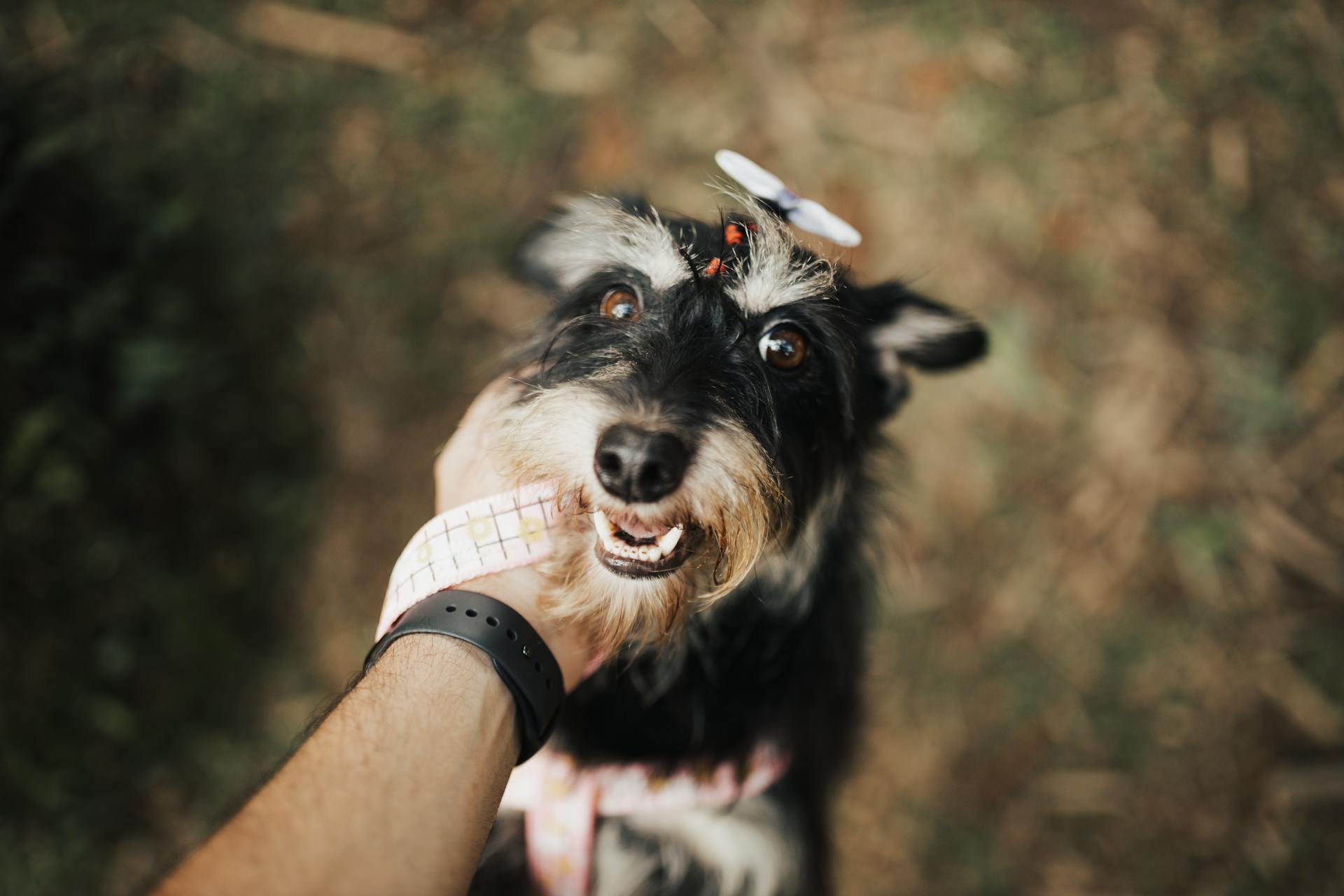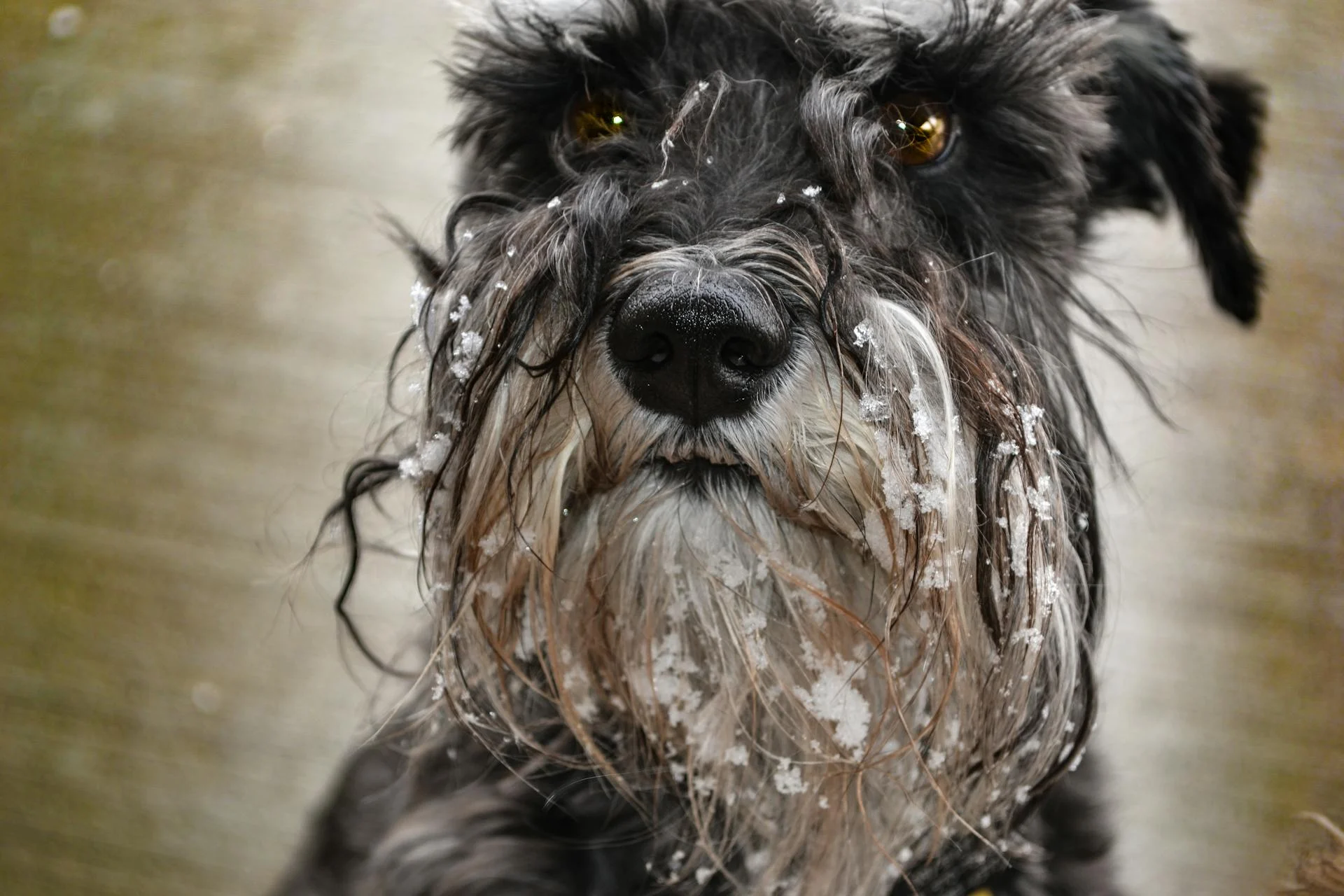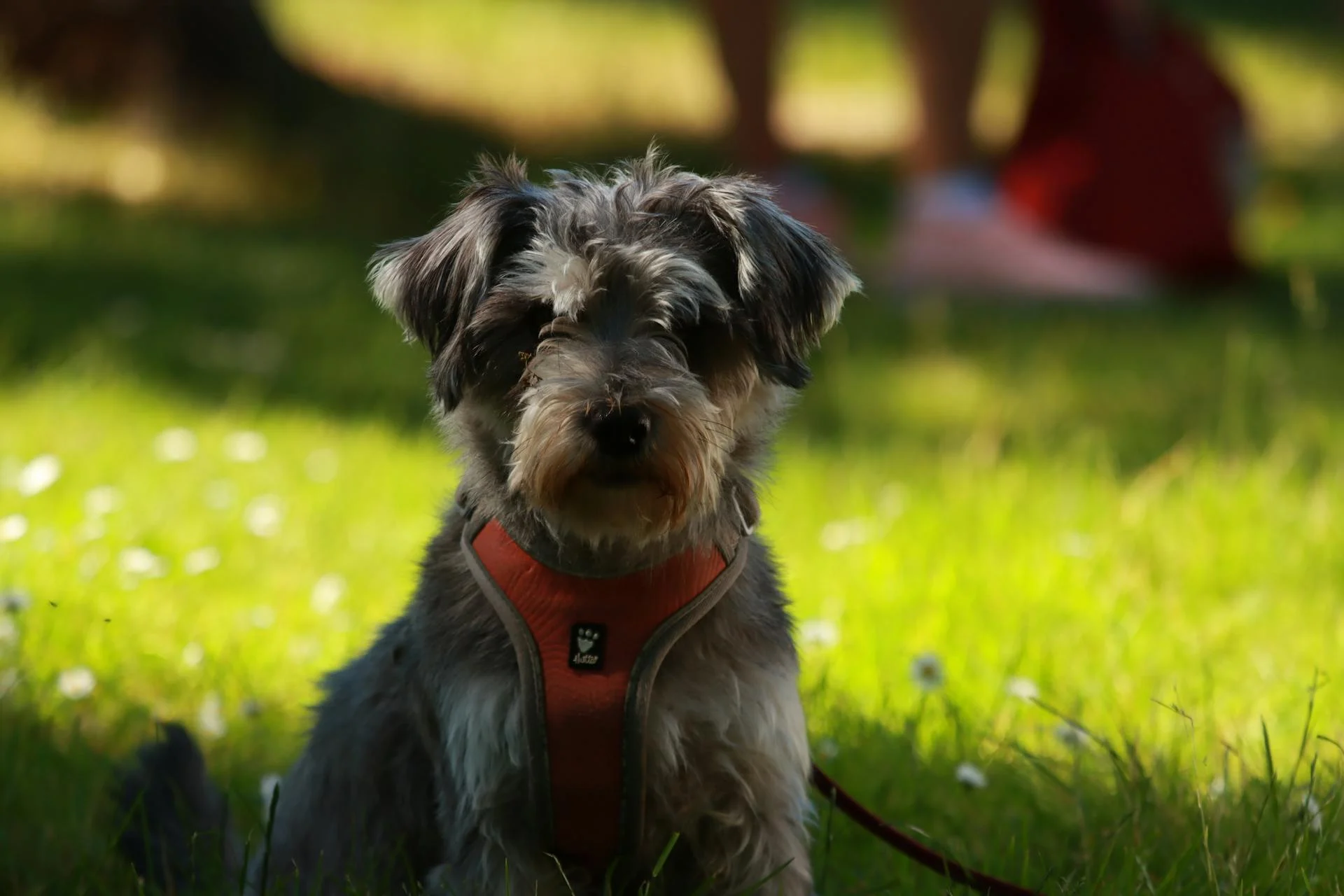
The Schnauzer family is quite diverse, with three main types: Miniature, Standard, and Giant. The Miniature Schnauzer is the smallest of the three, weighing between 11 and 18 pounds.
These tiny dogs have a big personality, often described as loyal and affectionate. They're highly intelligent and trainable, making them a great choice for first-time dog owners.
Types of Schnauzers
There are three main types of Schnauzers: Standard, Giant, and Miniature. The Standard Schnauzer is a medium-sized dog, typically weighing between 30 to 45 pounds and standing about 1.5 feet tall at the shoulder. They were originally bred as multifunctional dogs to catch rats and other rodents, as livestock and guard dogs, and later carried messages in times of war, helped the Red Cross, and were police dogs.
The Giant Schnauzer is the largest of the three breeds, weighing between 55 and 80 pounds and standing about 2 feet tall at the shoulder. They were developed in Swabia in the 17th century to drive livestock to market and guard farms, and later used as police and military dogs. Their intelligence and loyalty make them excellent guard dogs.
Consider reading: Schnauzer like Dogs
The Miniature Schnauzer is the smallest of the three breeds, weighing between 14 and 20 pounds and standing about 1 foot tall at the shoulder. They were developed since the late 19th century by crossing the original Standard Schnauzer with a smaller breed like the Affenpinscher, and Miniature Poodle. They are known for their friendly, obedient, and smart nature, making them great family dogs.
Here's a quick summary of the three breeds:
Heading
The Miniature Schnauzer is a small, lively breed that's perfect for families. They typically weigh between 11 to 20 pounds and stand about 12 to 14 inches tall.
Miniature Schnauzers have a distinctive wiry double coat that comes in various colors, including salt-and-pepper, black and silver, and solid black.
These dogs are known for their energetic and playful nature, making them great companions for kids. They are also friendly, obedient, and smart, which makes them relatively easy to train.
Miniature Schnauzers have a medium energy level, which means they need regular exercise to stay happy and healthy. They're also good with other pets, especially if introduced and socialized properly from a young age.
Here's a comparison of the three Schnauzer breeds:
As you can see, the Miniature Schnauzer is the smallest of the three breeds. They're a great choice for apartment living due to their smaller size and moderate exercise needs.
Despite their small size, Miniature Schnauzers are loyal and protective of their families. They make excellent watchdogs and are often described as friendly and outgoing.
Giant
The Giant Schnauzer is the largest of the Schnauzer breeds, weighing between 55 to 95 pounds and standing 23.5 to 27.5 inches tall.
They have a bold and imposing appearance with a dense, wiry coat that's typically solid black or salt-and-pepper. Their coat requires regular grooming to maintain its texture and appearance.
Giant Schnauzers are known for their protective instincts and loyalty to their families, making them excellent guard dogs. They can be wary of strangers and may not be as good with children as the Standard Schnauzer.
They are high-energy dogs that require regular exercise and mental stimulation to stay content. This means they need plenty of physical activity and engaging activities to keep them happy and healthy.
Despite their size, Giant Schnauzers are not considered a giant breed, but rather the largest of the Schnauzer types. They have an expected lifespan of 12 to 15 years with proper care.
Giant Schnauzers are intelligent and can be trained effectively with consistent and positive reinforcement methods. However, they can also be independent thinkers, so patience and firmness are essential in training.
Their intelligence also makes them suitable for various roles, such as police dogs, search and rescue, and herding. They excel in agility training and can be trained to serve as guard dogs, making them a versatile breed.
On a similar theme: Schnauzer Looking Dogs
White
White Schnauzers are a variant accepted in the breed standard, but not by the American or Canadian Kennel Clubs.
You can find white Schnauzers alongside the more common "salt and pepper" variety, which is also accepted in the breed standard.
The American and Canadian Kennel Clubs have specific requirements for the breed, but they don't recognize white Schnauzers as part of the breed standard.
On a similar theme: Miniature Schnauzer Breed Standard
Breed Information
Schnauzers come in three main breeds: Standard, Giant, and Miniature. The main differences between them lie in their size, energy levels, and temperament.
The Standard Schnauzer is a medium-sized dog, typically growing 18.5 to 19.5 inches tall and weighing 35 to 50 pounds. They have a wiry, non-shedding coat that requires regular grooming.
Giant Schnauzers are large, protective, and loyal dogs, often used as guard dogs. They grow around 2 ft tall at the shoulder and weigh between 55 and 80 lb. Miniature Schnauzers, on the other hand, are small, lively, and great for families, weighing between 14 and 20 lb.
Here's a brief overview of each breed's size and weight:
Overall, the size and weight of a Schnauzer breed will depend on the specific type, but they all share a similar wiry, non-shedding coat that requires regular grooming.
Breed Information
Schnauzers are known for being great family dogs, particularly the Miniature and Standard breeds, as they are affectionate, loyal, and often get along well with children and other pets.

Standard Schnauzers are medium-sized dogs with a distinctive coat that requires regular grooming, including brushing, trimming, and professional grooming to maintain its texture and appearance.
Miniature Schnauzers can adapt well to apartment living due to their smaller size and moderate exercise needs, while Standard and Giant Schnauzers are better suited to homes with more space and access to outdoor areas.
Giant Schnauzers are known for their protective instincts and make excellent guard dogs, being loyal to their families and wary of strangers.
Schnauzer breeds can live between 12 to 15 years with proper care, but they can be prone to certain health issues such as hip dysplasia, eye problems, and skin conditions, requiring regular veterinary check-ups.
Standard Schnauzers are highly intelligent and excel in performance sports like agility, tracking, and herding, making them versatile and good hunters and herders.
Schnauzer breeds are often good with children when properly socialized and raised with them, being playful and affectionate companions for kids.
Standard Schnauzers have strong personalities and can be stubborn, requiring consistent and firm guidance from owners to prevent them from ruling the household.
Expand your knowledge: Giant Schnauzer Grooming Styles
History
The Standard Schnauzer has a rich history that spans several centuries. Based on paintings by Renaissance artists, it's evident that dogs of this type have existed since the 1500s.
In Germany, Standard Schnauzers were used to guard farm families and livestock, herd cattle and sheep, get rid of vermin, and protect their owners as they traveled to market. This versatility made them an essential part of farm life.
German breeders took an interest in standardizing this breed in the mid-1800s by crossing them with the gray Wolfspitz and black German Poodles. This cross produced the distinctive texture and color of the breed's hair.
At the time, Standard Schnauzers were also crossed with other breeds to develop the Miniature Schnauzer and later, the Giant Schnauzer. This breeding history has shaped the breed into what we know today.
In their early years, Standard Schnauzers were called Wirehaired Pinschers. They were first exhibited at the Third German International Show in Hanover in 1879.
If this caught your attention, see: German Schnauzer
The breed's name "Schnauzer" is thought to refer to the breed's unique muzzle, which sports a beard and mustache. The name also pays homage to the first winner in the show ring.
During World War I, Standard Schnauzers were used to carry dispatches and aid Red Cross workers. They also worked as police dogs in Germany.
Some Standard Schnauzers were brought to the U.S. in the early 1900s by families who immigrated here, and by world travelers who fell in love with the breed in Germany.
Worth a look: Giant Schnauzer Germany
Size
The size of a Schnauzer can vary depending on the breed. Standard Schnauzers are medium-sized, with males ranging from 18 to 20 inches high at the shoulder and weighing 35 to 50 pounds.
Females are slightly smaller, measuring between 17 and 19 inches high at the shoulder and weighing 30 to 45 pounds. Giant Schnauzers are the largest of the three breeds, with males growing 25.5 to 27.5 inches tall and weighing 60 to 85 pounds.

Miniature Schnauzers, on the other hand, are the smallest, with males measuring around 1 ft (30 cm) tall at the shoulder and weighing between 14 and 20 lb (6.4 and 9.1 kg). Here's a summary of the size ranges for each breed:
Keep in mind that these are general size ranges, and individual dogs may vary.
Health
When it comes to the health of Standard Schnauzers, they are generally a robust breed with few health problems. Standard Schnauzers have very few health problems.
Hip dysplasia is a potential issue, but it's easily preventable with proper care. All breeding dogs should be radiographed clear of hip dysplasia.
Eye disease is another health concern, but it's manageable with regular testing. Annual eye exams are crucial to detect any potential eye problems.
A reputable breeder should be able to provide you with health clearances for both parents from the Orthopedic Foundation for Animals for hips and certification from the Canine Eye Registry Foundation (CERF) that the eyes are normal.
Genetics
Genetics plays a significant role in determining the characteristics of a breed. Research has shown that the Schnauzer breeds structurally cluster within "recent European descent, largely terriers and hounds" cluster.
The Schnauzer breeds, including Standard, Miniature, and Giant Schnauzers, have been studied extensively in genetic research. In a 2004 population genetics study, they were found to cluster within this specific group.
A 2010 GWAS study using over 48,000 single-nucleotide polymorphisms of 915 dogs from 85 breeds revealed that Standard and Giant Schnauzers made a separate phylogenetic tree branch, clustered among "modern" breeds like the German Shepherd Dog and the Portuguese Water Dog.
Standard and Miniature Schnauzers share common ancestry with spitz-type breeds such as the American Eskimo Dog and the Pomeranian. They form a unique broader clade in the 2017 WGS study of 1,346 dogs from 161 breeds.
The Giant Schnauzer, on the other hand, shares a haplotype with the other two Schnauzer breeds but makes a phylogenetic node in a separate clade, sharing common ancestry with the Black Russian Terrier and the Doberman Pinscher.
The genetic variants for the development of short tails among dog breeds were researched in a 2017 WGS study. The sampled Schnauzer and Rottweiler have "short tail phenotype caused by the unknown genetic factors" and are predicted to have developed short tails independently.
Here's an interesting read: Short Haired Schnauzer
Frequently Asked Questions
What two breeds make a schnauzer dog?
The Schnauzer is believed to have originated from a mix of the German Poodle and the German Pinscher breeds. However, the exact breeding history remains unclear due to varying scholarly opinions.
What is the difference between a Miniature Schnauzer and a Standard Schnauzer?
Miniature Schnauzers and Standard Schnauzers differ in size and temperament, with Standards being larger and potentially more stubborn, requiring more laborious training
Sources
- https://medium.com/@ngobichhuyen94/the-three-types-of-schnauzer-breeds-a-comprehensive-overview-198a0c664d26
- https://www.cuteness.com/blog/content/types-of-schnauzers
- https://www.animalwised.com/schnauzer-breeds-miniature-standard-and-giant-493.html
- https://en.wikipedia.org/wiki/Schnauzer
- https://dogtime.com/dog-breeds/standard-schnauzer
Featured Images: pexels.com

